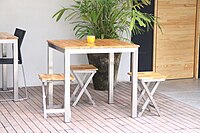
Back تصميم إيكولوجي Arabic Ekodesign Czech Ecodesign German Οικολογικός σχεδιασμός Greek Ecodiseño Spanish Ökodisain Estonian Ekodiseinu Basque طراحی بومشناختی Persian Écoconception French תכנון סביבתי HE
This article needs additional citations for verification. (August 2020) |

Ecological design or ecodesign is an approach to designing products and services that gives special consideration to the environmental impacts of a product over its entire lifecycle. Sim Van der Ryn and Stuart Cowan define it as "any form of design that minimizes environmentally destructive impacts by integrating itself with living processes."[1] Ecological design can also be defined as the process of integrating environmental considerations into design and development with the aim of reducing environmental impacts of products through their life cycle.[2]
The idea helps connect scattered efforts to address environmental issues in architecture, agriculture, engineering, and ecological restoration, among others. The term was first used by John Button in 1998. [citation needed] Ecological design was originally conceptualized as the “adding in “of environmental factor to the design process, but later turned to the details of eco-design practice, such as product system or individual product or industry as a whole.[3] With the inclusion of life cycle modeling techniques, ecological design was related to the new interdisciplinary subject of industrial ecology.
© MMXXIII Rich X Search. We shall prevail. All rights reserved. Rich X Search